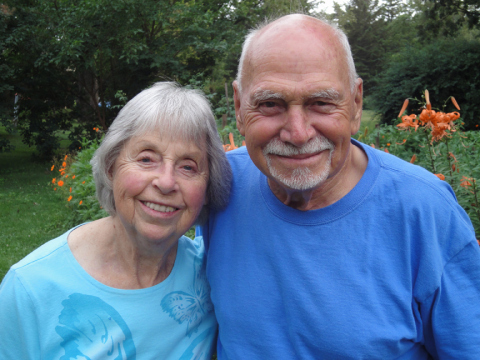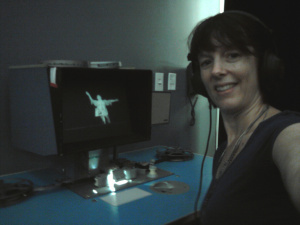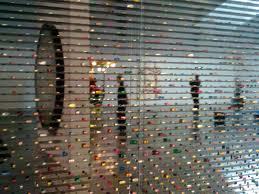Teresa Bruce's Blog, page 43
August 9, 2012
Smart stuff my father-in-law says
That’s Joe – on the right – next to his beautiful wife Angie. You may remember this picture from my blog about his 90th birthday party last summer. Well now he’s 91 and still just as sharp. We’re in Wisconsin watching the news together on the couch, which is when most of his bon mots come out (as opposed to rants, more common in our Beaufort house) He says I can share two with you free of charge.
The first came up when Gary wanted to know where the key to the family’s 1974-era pontoon boat might be. It wasn’t in the usual place, which didn’t matter because Joe follows his own advice.
“It’s easy to feel stupid as you age because you forget where you put things. So just buy two or three of everything you commonly need and scatter them about the house. Viola – you double or triple your chances of finding it!”
The second piece of wisdom came after Joe asked me what I’ve been typing all day. I actually took my laptop with me to finish a chapter on the Byrne book. He asked who proofreads for me and I told him Gary usually has first look – before it goes off to my real editor – Susan Kammeraad Campbell at Joggling Board Press. He considers his job to catch cliches, mushy stuff he thinks will bore readers and the occasional error of fact. Like this one that slipped into my description of first approaching Byrne’s garden I won’t say how many years ago:
“The air smelled of salt, wisteria and bolting rosemary.”
Gary said “Rosemary doesn’t bolt. The rest’s okay.” So I confirmed it with my garden guru Will Balk, changed it to bolting cilantro, and sent the chapter off to Susan.
Joe thinks that was a bad idea. “You should leave a few dumb things like that in. That way when the book comes out and critics complain, at least you’ll know they really read it.”
Now that’s some 91-year-old Midwestern logic for you. Hmm…bolting rosemary might have to go back in.


August 4, 2012
Not so bella Bela
Not surprisingly, I’ve been glued to the partial telecasts of the London 2012 Olympic gymnastics competition – despite the horrific commentary by people who should know better Elfi. I hope that enough time has passed since Gabby Douglas’s soaring all-around victory that discussing the not-so-upbeat side of the sport in no way cuts into her glory. But several friends have wondered what I thought of this article - about the recent tell-all memoir of Dominique Moceanu. I think she’s as brave as Gabby for speaking out. She’s right – what medal-hungry Americans accept as training is child abuse by any other name. That growling, media-clamoring bear-of-a-coach we all know as Bela Karolyi (and his other half Marta) is only one of a string of foreign-born gymnastics coaches who make great gymnasts overseas and then impose the same system on our girls. They’re proven champion-builders (Bela and Marta started with Nadia, remember her?) but it’s a warped system. The injuries the system promotes, which is what Dominique’s book deals with, are only part of the picture. Coaches who try to recreate Eastern European gymnasts on American bodies also enforce anorexia. And it’s probably even worse in Rhythmic Gymnastics where the Eastern European waif-thin body type still dominates the sport.
I know because I was scarred by it myself. At Olympic Training Camp in Colorado Springs the U.S. Rhythmic National group-routine team was ordered to run laps before and after each practice – the first run to sweat off any lingering effects of dinner the night before our morning weigh-in; the second one to sweat off any sips of water we drank during six hours of practise. Every day I didn’t lose weight I was threatened with expulsion from the team and I didn’t think my parents could afford a plane ticket home. It took years after a broken back ended my rhythmic career to even get a monthly cycle back, let alone a healthy attitude toward food. A disgusted gynecologist told my mother I might not ever be able to have children. A psychologist told me I had a form of PTSD. I’ll never forget a meal served to me by the Bela of rhythmic gymnastics in my day – Alla Svirsky. It was the night before my first World Championship in Strasburg, France. My parents were thousands of unsuspecting miles away. And I was told to eat a tomato for dinner, only a tomato, so that I’d lose another half pound or so before the judges saw me. I fainted three times during the competition, which was no big deal to our Russian coaches. We all collapsed after every routine but as long as we looked as skinny as the gymnasts they used to train, it was okay by them.
I say all this not out of sour grapes. I survived the sport and went on to a happy and fulfilled life. I still love to watch these competitions, but I can’t help but think if I ever did have a daughter I’d never send her off to train under one of those coaches. Some things never seem to change.


July 25, 2012
Mermaids and Karma
I’ve been dwelling a lot on karma these days, maybe because it’s too hot to do anything more productive – like contemplating or considering or rejecting karma. It may not even qualify as karma, but I’m referring to the kind that goes like this: if you make up a story to get out of a bind that story will end up coming true.
What this has to do with mermaids is this. Many of you know that I am one, have been long before Disney merchandised the whole concept with that cloying Aerial. But for the past two months I’ve had to stay clear of the river that flows in front of my house because of a small but pesky open wound that may or may not have started from a spider bite. For a mermaid, not being allowed to swim is the equivalent of being grounded. I’m not the only one. A mermaid sister of mine, Lolita, has been grounded thanks to a nearly-broken back. We’re both miserable. Which is why I’m wondering if karma is to blame. I can’t speak for my mermaid sister’s case, but I may have had it coming.
About three years ago I invented a story. (Okay lied.) I told my inquisitive nephew Brandon that the reason he couldn’t see my tail anymore* is because I was grounded by mermaid management. It isn’t necessarily permanent, but until the powers that be say so, I am no longer a mermaid.
*The tail he once saw (full disclosure here) was a costume I rented before his little brother could walk and before his little sister was born. On a visit to Florida, I wore the costume in his bathtub and posed for this picture. This does not prove that I am not a real mermaid. It was simply easier than auditioning for the Weeki Wachee mermaid show or giving up my voice to marry a prince. I’ve been Auntie Mermaid ever since.
I come by mermaidenhood honestly. I wanted to be a ballerina but I wasn’t tall enough. As I’m explaining in the book I’m writing for Joggling Board Press, my mother conveniently taught swimming lessons at the Hillsboro, Oregon indoor pool. Here’s a little sample (not yet edited):
”I spent hours each summer day cross-legged at the bottom of the shallow end, holding my breath and trying not to puff out my cheeks too much. Through the stinging, chlorinated water I looked up at my mother’s legs, treading water, and resolved never to look like I was riding a bicycle. I squeezed my legs together instead, pointing my toes and bending at the hip to propel myself under the struggling students. Blowing tiny bubbles from my nose, I could undulate across the entire length of the pool without coming up for air. I refused to wash my hair with the special chlorine rinse my mother used because I wanted my blonde hair to turn green, like the moss tangled in the illustrated Little Mermaid’s locks.”
I loved that my nephew knew me not as Teresa but as his Auntie Mermaid. But once he reached about ten the questions started coming fast and furious.
Q: Why doesn’t your tail come out every time you swim?
A: I have special lotion (sunscreen) that I always put on my legs to keep my tail invisible.
Q: Is Gary a merman?
A: No. He’s not a good enough swimmer.
Q: Can’t you make him one?
A: No, I love him too much to drown him.
Q: We won’t tell anyone. Can’t we see the tail again?
A: Sorry. Mermaid management found out about the first time you saw my tail and that’s why I’m grounded.
See what I mean about karma? The story I told to get out of a bind has actually come true, just ten years later. Swimming in the life-giving, organism-filled waters of our tidal ecosystem is a recipe for flesh-eating bacteria. I didn’t just ascertain this from the tabloids – actual doctors concurred. Wait until all broken skin is completely healed. No matter how hot and humid it is. This weekend marks the all-clear mark when it’s safe for me to swim again. So for the sake of karma, don’t mention it if you see a mermaid’s tail break the surface of the water.


July 18, 2012
Too Green?
There is a price to pay for being too green, I’ve decided. The corollary to my theory is that there is such a thing as eating too healthy – which my sister reminds me of every time I visit her, eat even a morsel of the tasty processed snacks she feeds her children, and then have digestive hell to pay. “Your body is too picky,” she tells me, “you’ve lost your normal food immunity.”
That, unfortunately, I can’t help. I’m doomed to eat healthy food by virtue of vanity and no health insurance. But this green thing, I’m beginning to wonder about. Starting a compost pile seemed like the right thing to do when we moved back to Beaufort. Turns out it does nothing to help our drought-battered sandy soil but we inadvertently created a nightly buffet for every rodent in Pigeon Point. Word apparently spread. Byrne Miller’s old house is fair game – they only have a cat and she’s trapped behind a screen porch!
The green penalty increased over time. Gary labored over a garden, only to have our first melons mysteriously disappear the night before we planned on harvesting them. He has a theory that only raccoons are smart enough to rig up some leverage device or stand on their hind legs and roll a heavy melon out of a raised garden. Me, I give squirrels the credit. They are even pickier eaters than I am and sample every tomato before deigning them unfit for our consumption. The melon obviously met with their approval and they simply amassed an army of their friends to take our prize.
I use the military analogy because squirrels are winning the war, let there be no doubt. When we decided to be even greener and put out bird seed during the drought, Gary had to buy a BB gun to keep the squirrels away. It is on ongoing standoff and the rats with fluffy tails resume the assault the minute he puts away the gun. Same goes with the water we put out for the birds during the heat wave this summer. Every night we watch families of raccoons finish their buffet dinner at our compost pile with a leisurely draining of the bird bowl. They’re often too full to waddle into the bushes to use the bathroom and find our deck quite convenient and sanitary.
It isn’t just the Low Country that retaliates against being too green. Last week we stayed at Kim Gundler’s rental cabin near Asheville, North Carolina. It sits on a working farm and the coolest thing about staying there is that you get to join the farmers and pick whatever produce you can eat. The okra was fuzzy and plump, the onions sweet and juicy and zucchini too tender to pass up. So I baked zucchini bread – the greenest, healthiest zucchini bread you can imagine. I used olive oil instead of butter and cane molasses made right there on the farm instead of sugar. Kim’s little log cabin smelled just like I imagined Laura Ingalls’ would have and I put the loaf outside on the porch to cool while we played a game of cards. It was dark when we remembered our healthy dessert and we couldn’t see it right away. We searched by flashlight but the empty loaf tin was halfway to the barn by the time we found it. If I’d stuck to a store-bought Sara Lee loaf full of preservatives and high fructose corn syrup, I’m sure the vegan, free range, organic raccoons of North Carolina would have turned up their noses.
The first night we were back from the farm, I put a fresh bar of soap on the tray of our outdoor shower. There is nothing more refreshing than a hose-supplied, un-heated shower under the Live Oak trees during a Low Country summer. But the next morning the soap was gone. I searched under the porch, thinking maybe I had knocked it off the deck in the dark. No luck, so I dug up our last bar of Trader Joe’s soap. We ignore our carbon footprint and make pilgrimages to North Charleston for this soap –it’s cruelty-free, Tea Tree Oil, pure vegetable soap. You don’t come out of a shower after using this soap smelling like a strawberry Margarita or an Irish sailor. You smell like, well, a freshly washed zucchini. Which is probably why we heard a thump at three this morning. Rosie snarled at the sliding glass door that leads out to the deck and the outdoor shower and Gary turned on the light to investigate. There, hanging from the privacy shutters that block our shower from our neighbor’s view, was a young opossum. Under her, covered in claw and tooth marks, was a freshly dropped bar of Trader Joe’s soap. Is a reclaimed wood, punched tin soap safe far behind?


July 9, 2012
Writing, unplugged
If our car’s leaky battery cooperates, we’ll be spending a week at a friend’s rental farmhouse property near Ashville North Carolina. I’ve had more than a month to prepare for this week; my laptop is packed and I still have a chapter of “Dancing with Byrne” to write even though we’ve declared it a vacation. But still, I’m a little at odds over the fact that there is no internet where we’re going. If you know me, this is a ridiculous apprehension – I am not far from a techo-dolt and my cell phone is definitely smarter than I am. I’ve literally driven to the end of the earth (well, at least as far as its possible to drive, Tierra del Fuego) without “connectivity” beyond internet cafés every couple of weeks.
The thing is, the foothills of Ashville don’t seem far enough away for my body to enter isolation mode. I know there are earth-friendly, vegan wi-fi hangouts next to every micro-brewery; a download is only a drive away. So my brain is refusing to call up the skills I’ve developed over a life-time of solitary ventures. What will I do when there’s a fact about 1930s New York (where Byrne came of age) that I need to know, even if it’ll never end up in the book? I’m so used to having the internet as a decompression tool, a procrastination ally, that it’s a tad more intimidating than I’d like to admit to go for a week without it. It’s like dieting. I can do it if there’s nothing tempting in the fridge.

Duncan in Connecticut
So, as usual, I wonder what Byrne would make of my conundrum. And then I laugh. She and Duncan used to retire from Beaufort summers as hot as this one every year. Not to Ashville, but to Connecticut – another of their stopping points on the fascinating journey of their married life. Byrne didn’t stop working during these summer breaks – she just taught dance and spread “womenisms” to different students. Duncan managed to keep writing because he couldn’t help it. And all of this transpired in a house where there was, of course, no internet but in a house that didn’t even have electricity or running water! Their two daughters slept in a tree house and Byrne bathed by well-water. Duncan took a wonderful photograph of her, in a perfect modern-dance spiral position on the ground, pouring bowlfuls of water over her naked body. I love how comfortable she looks, as though this was nothing out of the ordinary. It is natural – if only for such an extraordinary woman.
So the hell with the internet – I’ll write from within my own life and mind. And who knows, maybe there’s a well on the farm somewhere.








July 2, 2012
Why Women Can’t Be It All
If hell hath no fury like a woman scorned, try scorned feminists. Anne-Marie Slaughter clearly knew what to expect when she, the former Director of Policy Planning at the State Department under Hillary Clinton, wrote a piece for The Atlantic called “Why Women Still Can’t Have It All.” Slaughter covers all her bases in the piece – she’s self-deprecating, apologetic for her economic privilege and acknowledges the trail-blazing sacrifices of the generation of women who broke glass ceilings before we called them that. But by writing her truth, couched as it was in political correctness, she still created a fire-storm of reaction. I listened to the exchanges on my favorite radio program, Tom Ashbrook’s “On Point,” and found myself thinking of a trail-blazing woman of another generation: Byrne Miller. She’s long-gone now, but Byrne would have argued that Slaughter is framing the entire question incorrectly: it isn’t that women can’t have it all; they don’t need to be it all.
I’m writing a book about Byrne – she was a radical, modern dance pioneer who raised two girls while her schizophrenic husband meandered the family from Manhattan to Santa Fe to St. Thomas and finally Beaufort, South Carolina. Her husband was one of the original Mad Men of advertising, surrounded by beautiful models and social conventions that would have driven most stay-at-home wives to a jealous distraction.
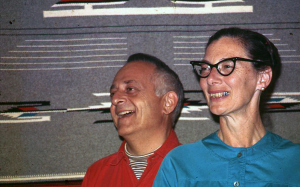
Byrne and Duncan Miller
She found a way to balance Duncan’s needs (maybe more so than her daughter’s) with her artistic ambitions in a way that might shock women of my generation. She and Duncan agreed to an open marriage during the most stressful years of child-rearing (one of her daughters also had schizophrenia) and instead kept an emotional fidelity through those troubled times as well as the decades when their marriage was more conventional. They were a month short of their 60th wedding anniversary when Duncan died. Byrne always told her own daughters, and many others she “adopted” along her amazing journey, that a woman should never try to be everything to a man.
“There will always be a woman more beautiful, or more witty, or more sophisticated than you,” she told us all. “Which is why it is insane to try and be all of those things at any given time. Just trust that the right man can’t live without the unique combination of traits that define you.”
Hang on, I’m getting to a parallel to the work/life balance struggle that Slaughter points out keeps mothers from rising to the most powerful jobs in this country today. Courageous women like her try to be everything to everyone – especially to their children. Byrne would argue it can’t be done; I would add that it isn’t as necessary as societal pressure makes it seem. Mothers, just like fathers, don’t have to be at every recital, put band-aids on every boo-boo and home-cook every meal for their children to turn into functional, happy adults. Women who feel compelled to be super-moms as well as super-achievers in a competitive workplace have contributed to a generation of young adults who have never been allowed to fail, who have never had to fend for themselves.
Or, worse yet, have never had the experience I had with Byrne Miller. She became a second mother to me, one who expanded my horizons and filled different needs than my mother could. Slaughter’s own former boss Hillary Clinton might agree – it really does take a village to have it all.








June 27, 2012
From Limon, with love
If my memoir about Byrne Miller were a traditional biography, I’d be trolling through genealogy records to trace her roots. But Byrne’s biological ancestry is less important to me than her dance heritage – so I bought a ticket to see the Jose Limon dance company in New York last week.
The New York Times reviewer didn’t seem impressed, but I know with utter certainty that Byrne would have given him an earful. She reviewed dozens of performances by dancers (she was tough, once calling Pilobolus “boring”)and the NYT reviewer missed all the aspects that she would have found so powerful in Limon’s work. The dancers were hypnotically rhythmic and understated – they aren’t actors, they let the steps lead to a story. Byrne once said she feared modern dance was becoming too athletic – that the artistry was being lost. In Jose Limon’s legacy company, she can rest in peace. The dancers are strong but never overpowering; they work the floor as much as the air above it.
A woman danced the piece Jose Limon created for himself, the 1942 “Chaconne,” set to Bach’s Partita No. 2 in D minor for unaccompanied violin, and she was restrained in her power and expression because he was. She even wore men’s clothing. It wasn’t about her interpretation of his choreography; she was giving the audience the gift of time travel. I saw in her the connections Byrne once made. I stood up cheering wildly, just like the rest of the audience, when she took her formal bow at the waist – she was accepting appreciation for his work as much as hers.
In Limon’s choreography, I see Byrne’s inspiration and an eerily similar path to dance. Byrne started out training to be a classical pianist and was sucked into the vortex of dance when she saw Harald Kreutzberg perform an opening act for a Saturday matinée in the 1920s. The same thing happened to the Mexican painter Jose Limon; he saw Harald and gave over his life to dance.
Though I have no evidence that Byrne’s and Limon’s paths directly crossed, they share another pivotal connection. The handsome German dancer Lucas Hoving gave up ballet to dance for the company Limon eventually founded, and Byrne ended up being the principal dancer in the company Lucas Hoving eventually created in Connecticut. It’s like that in dance – the students become the teachers, the protégé’s add to the body of knowledge and transcend it. Byrne Miller certainly did her part.








June 22, 2012
Finding Byrne in New York
Greetings from about a mile from where Byrne and Duncan shared their first apartment as a married couple. We’re here in Manhattan doing a little research into Byrne’s early years. I’m working on a new rewrite – with my wonderful editor Susan Kammeraad-Campbell of Joggling Board Press. I’m trying to get inside Byrne’s point of view, rather than recount the stories she told me and other “adopted” children.
So I’ve poured over all the notes and journal entries she left behind, concentrating on the little things that never made grand stories on her porch in Beaufort. Like the first crush she ever had…on a German modern dancer named Harald Kreutzberg. She wrote him fan letters and was desperate that her mother never find out because he was that outrageous. That’s him – on the reel-to-reel screen behind me at the NY Public Library for the Performing Arts in Lincoln Center. He performed his “expressionism” in opening acts on the stages where Byrne would watch Saturday matinees. I’d seen pictures of him on the internet – wild, theatrical portraits that today seem vaguely homoerotic but probably weren’t then. Photos, though, can’t touch the impact of actually seeing him move. This was a dancer I would swoon over – so strange to find an almost childish connection to Byrne eleven years after she left us but there you have it. I only wish I could record some of the films and share them with you all…but it’ll be my job, and my delight…to think of the words to transport you. Wish me luck!








May 4, 2012
On admiring pharmaceuticals in London
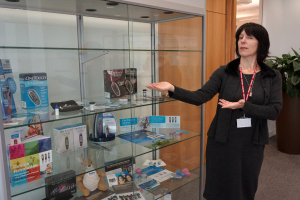
Hours waiting at customs, TSA officials looking at see-through body scans of your junk, schlepping cases of photo gear around corporate offices – all of this is the decidedly non-glamorous side of producing corporate videos. But when you have a Sunday off in London and get to see the hottest new exhibit at the Tate Modern – it’s hard to beat. Hence my photographic homage to Damien Hirst above – on the left: his life-size pharmacy room and on the right: me on location at the corporate headquarters of the health care company we were shooting. Not bad eh?
Admittedly, Hirst’s “Pharmacy” was not one of the highpoints of his retrospective. The art speak goes “coloured liquids representing the four elements of earth, air, fire and water – suggesting the palliative power of modern medicine.” Whatever. Hirst himself is a little more honest about it: “You can only cure people for so long and then they’re going to die anyway.”
I knew I’d be shocked and awed by the outrageous Hirst pieces – the shark suspended in a tank, the stained glass windows made of butterfly wings, the severed head of a cow designed to grow maggots etc. I didn’t expect to be as moved as I was by his series of stainless steel cabinets containing facsimile pills – each one individually produced to replicate actual medicine. They’re beautiful, set against the mirrored background that forces you to see yourself in the pills we all consume.
Hirst made all the other contemporary, conceptual art at the Tate look like art-school projects, and high school art school projects at that. Check out the video tour (it’s worth the commercial at the head) to see how big this guy thinks. http://arrestedmotion.com/2012/04/videos-damien-hirst-retrospective-tate-modern/
I complain about Gary’s collection of dead things he photographs, but at least we don’t have a wall-sized disc of black flies or a wall dripping with butterfly-hatching goo. Maybe that’s why I loved the video on the bottom floor of the Tate where Hirst recalls his mother saying, “Oh for the love of God,” every time he started a new project. It’s the title of the centerpiece in the show: the diamond-encrusted human skull. If only I could get Gary to start lining all of his deer jaws with rubies or jade….








April 18, 2012
Eat Soft Shell Crabs, then come listen to poetry
April is National Poetry month so this Saturday Otram Slabess will be staging our annual outdoor poetry reading at the Charles St. Gallery. I know, I know, there’s a lot going on in Beaufort this weekend. All the more reason to take a time-out at three in the afternoon and let the metered words of some wonderful writers soothe your hurried soul. Trust me, standing in line for an hour for an over-priced soft shell crab in Port Royal will make you crave a glass of wine, a chair, and the artistic shade of Lyals and Georgia’s gallery garden.
Before we open up the microphone, each Otram Slabess member (founders Warren Slesinger and Quitman Marshall, plus Steve Johnson, Jacquelyn Markham, Karen Peluso and me) will read a piece they’ve written, and one by a poet from the larger universe. I don’t know which I’m looking forward to more – my fellow writers are so accomplished and lyrical and entertaining that I joined the group just to hear their works in progress every month. I don’t even write poetry, but I love how these part-time teachers, publishers, parents and artists tangle with thoughts and words and even commas. They don’t make a living off of their poems (oh unjust world) but poetry is what grounds and inspires them. To listen to them read their own work is an invitation to see the world as they do. To hear them read their muses is an interior window and just as revealing.
I’m going to be reading a poem by Starkey Flythe, an award-winning South Carolina poet who spoke at a meeting of the Poetry Society of SC in Beaufort this February which Warren and Quitman hosted and arranged. He’s a brilliant and funny octogenarian; he advised the poets in attendance to have their portraits taken while they are young and said that education is meant to bore children to death at great expense. I find his poems as charming as he is, yet for the workshop he had us read poems about defacing graves and wrestling angels. His point was that poetry is more than rhymes of love and odes to azaleas. He encourages writers to tackle not the grand but the intimate.
Which is why I love the annual Otram Slabess poetry reading at the Charles St. Galley. It’s intimate. In Lyal’s garden you are close enough to jasmine to get drunk on it, you sit near enough to your neighbors to see what poems make them smile or cry or both at the same time.
To get you in the mood for Saturday, I highly recommend subscribing to a free email/facebook/twitter offering by Knopf Poetry. Every day in April, and we still have a few, they’ll send you a wonderful poem by known or emerging star in the world of poetry. You can friend or follow them, or try the e:mail address that appears in my mailbox everyday:
knopfpoetry@information.randomhouse.com
See you Saturday!









